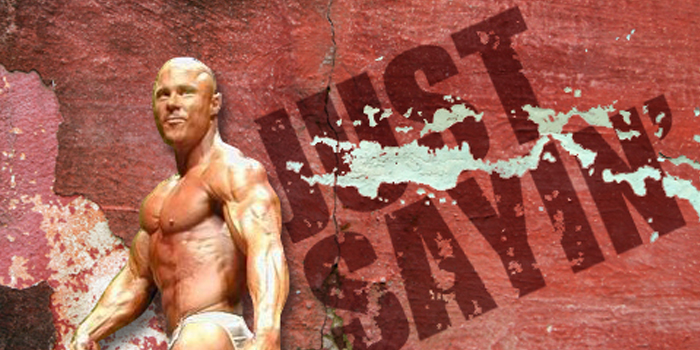
As an industry, we have come to a place where we feel that unless we complicate things, it won’t seem advanced or “science-y” enough. Our ideas won’t sound revolutionary if we don’t use acronyms, big words, and long explanations. My position has always been that training is simple or more rudimentary than nutrition or supplementation. If there are going to be huge advances made in ways we can get huge, it will be how nutrition and supplementation impact growth versus some “new” way to train that hasn’t been thought of before.
RECENT: Can I Continue to Build Muscle in My 40s Without Getting Injured?
Just about the time I feel I have heard it all, we now have acronyms to explain the reps we should NOT do, to keep us from taking a set to failure. WTF? And we also have the people in these camps citing studies to prove how effective this type of training is.
Here is something to take into consideration when it comes to studies: You can find a study to substantiate almost any claim you care to make. For that reason alone, I don’t put a lot of significance into studies. I won’t say they are useless, but I will say that they don’t hold as much weight as someone who can take mediocre genetics to their own version of huge. What has worked to get huge longer than any other factor, ever?
TRAINING YOUR ASS OFF.

Jasminko Ibrakovic © 123rf.com
We can mull over study after study, and we can talk about the risk of injury, overtraining, CNS impact, adaptation, whether to train heavy or light, blah, blah, blah. The reality is that the people you see in the gym working their asses off are the ones who almost always progress significantly better than those who don’t work very hard.
You want to get big fast? Assuming you are eating enough, sleeping enough, and recovering enough, you need to train to failure. I define failure as pushing a set to the point where you cannot get another rep during a set. You either fail during the attempt of another rep or you are absolutely certain that if you attempt another rep you will eat it. Doing this means you are providing a stimulus that is forcing an adaptation for that muscle.
There are other options to provide a stimulus that force adaptation like going beyond failure with forced reps, rest-pause, drop sets, etc. However, it is my opinion that failure is more of a black-and-white measure because once you pass failure and start adding in other variables, it becomes difficult to measure those variables.
How much more intense is a rest-pause set versus a drop set? How much more intense is doing a drop set versus forced reps? What if your spotter is doing 80 percent of the forced reps versus if he was busting your ass to do 80 percent and he was only doing 20 percent? With failure, the measure is very black and white without added variables.
The only other question to ponder is: “How many sets to failure are optimal to grow as efficiently as possible?”
Everyone has different recovery abilities, so one person may only need one set per exercise to failure for three exercises to provide enough of a stimulus for growth. Another person may need twice that, while a third person might respond to three sets to failure but respond considerably better to twice that. The answer to the question of how much volume to use is simple: You will need to use trial and error, just as you would for any other training method that you would employ.

Jasminko Ibrakovic © 123rf.com
The easiest way to do this is to start low and build volume based on your response. One set to failure for three different exercises would be a good place to start for major muscle groups. Keep this same volume for two weeks, and if you respond well, increase volume for another two weeks. As simple as this may sound, you will come to a place where you have two basic options:
- You are making pretty good gains and want to leave well enough alone.
- You want to continue to push the volume up every two weeks until you feel that your gains are slowing or becoming compromised. From there, you would know your ceiling and you could then back off to a level of volume that you are comfortable with and that has proved to be successful for you.
The first option above is a safe one, and there is absolutely nothing wrong with using this option and progressing. The second option is more for those who like to see how far they can push it and who want to maximize their progress as much as possible.
RELATED: Newton's Third Law (of Gains)
That’s it. There’s your system.
I realize that this system is not very fancy, doesn’t have a cool, catchy name, and if you are asking what training plan you are currently using, you won’t have an answer that a fellow gym-rat can recognize and be impressed with. However, I can’t help but think that most people would prefer to be making consistent gains and getting bigger and stronger versus having some cool response to a question that shouldn’t even matter.
This system also means you will be working your ass off to grow and progress — you know, kind of like how this game was set up from the start, before Insta-trainers came along and tried to rewrite the most basic laws of getting huge. Despite changes in technology, training equipment, gyms, and workout gear, the most basic of principles have remained constant for a very long time:
To build muscle, you need to provide a stimulus that the muscle has not seen or is not accustomed to for it to adapt and grow. Knowing this, you tell me if leaving three reps in the tank and not going to failure is going to provide an adaptive response. Sometimes, we all just need to sit back and approach these things from a very simple and logical position. When we do, the answers seem to be so much more obvious. Just Sayin’.










